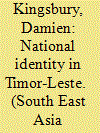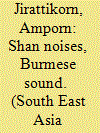| Srl | Item |
| 1 |
ID:
095142


|
|
|
|
|
| Publication |
2010.
|
| Summary/Abstract |
Following a long independence struggle and international intervention, in 2006 the tiny impoverished state of Timor-Leste almost imploded in civil chaos and institutional collapse. The events of the time were quickly defined in terms of an east-west geographical and, broadly, linguistic and political divide, corresponding to pro- and anti-government groupings. International intervention quelled the worst of the violence, although elections in 2007 confirmed the general tendency, if not an absolute alignment, to the divide that had appeared in 2006. However, much also united Timor-Leste historically and culturally and, increasingly, in a broad acceptance of civic institutions. It was from this base that the small and sometimes fragile state began to build what promised to be a more coherent future.
|
|
|
|
|
|
|
|
|
|
|
|
|
|
|
|
| 2 |
ID:
095144


|
|
|
|
|
| Publication |
2010.
|
| Summary/Abstract |
This paper examines how ethnic Shan singers use the Burmese language to redefine their own ethnic identity, in the process helping to construct Shans' place in the Burmese national imaginary. The paper focuses on the songs of two Shan artists, Sai Htee Saing and Sai Sai Mao. These two singers have been singing in Burmese for three decades. Both have gained nationwide popularity and are now among the most famous singers in Burma's music industry. The paper consists of two parts. The first one discusses the dynamics of self-representation, examining how Shan artists select and adapt dominant discourses about them to their own task of crafting themselves. The second part investigates the audience reception of these two singers, exploring how particular groups of audience members bring their own ethnicity into interpreting a media text. Through participant observation, interviews with audiences and with the singers themselves, the author seeks to illuminate how such self-fashioning and listening practices reveal complex relations between ethnicity and the popular construction of identity.
|
|
|
|
|
|
|
|
|
|
|
|
|
|
|
|
| 3 |
ID:
102633


|
|
|
|
|
| Publication |
New Delhi, Lok Sabha Secretariat, 2009.
|
| Description |
12p.
|
| Series |
Parliamentary procedure abstract series; 27
|
|
|
|
|
|
|
|
|
|
|
|
Copies: C:1/I:0,R:1,Q:0
Circulation
| Accession# | Call# | Current Location | Status | Policy | Location |
| 055710 | 328.404/IND 055710 | Main | On Shelf | Reference books | |
|
|
|
|